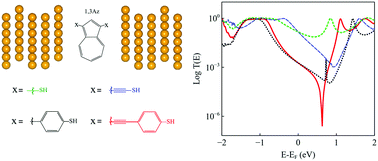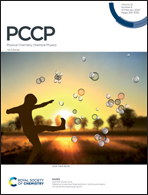Reassessing destructive quantum interference in azulene-based devices†
Abstract
Quantum interference (QI) effects have recently attracted increased interest in electron transport studies of single molecular junctions. Although QI effects have been explained in a variety of molecular devices by different chemical rules, such as orbital-based prediction, the graphical scheme, and cross-conjugated states, recently, experimental and theoretical reports have claimed to have reached a better understanding of QI features. In particular, azulene molecule derivatives present an insightful case study where these simple rules of thumb can fail. Here, we explore the validity of graphical rules and the effects of closed loops in the azulene molecular structure. The electron transport behavior through an azulene core with different moieties (thiol, ethynyl-thiol, phenyl-thiol, and ethynyl–phenyl-thiol) was investigated with first-principles calculations combined with the non-equilibrium Green's function (NEGF) technique. The transmission spectra at zero bias show that the graphical rules are not sufficient to predict and explain the destructive QI effect in these azulene derivatives. Instead, closed-loop diagrams should be taken into account to properly describe the transport properties in those systems, but the presence of a closed-loop does not necessarily lead to the absence of destructive QI in the transmission spectrum. Our results indicate that the destructive QI effect is found when the azulene core is coupled at the 4,7Az-, 5,7Az- and 1,3Az-positions with ethynyl–phenyl-thiol moieties, while no obvious destructive QI effect is observed in the other azulene derivatives, either with the thiol, ethynyl-thiol or phenyl-thiol anchoring groups. We also demonstrated that the I–V curves depend more strongly on anchoring groups than the coupling position.



 Please wait while we load your content...
Please wait while we load your content...